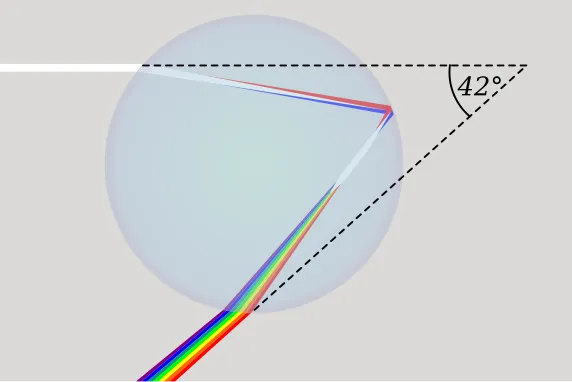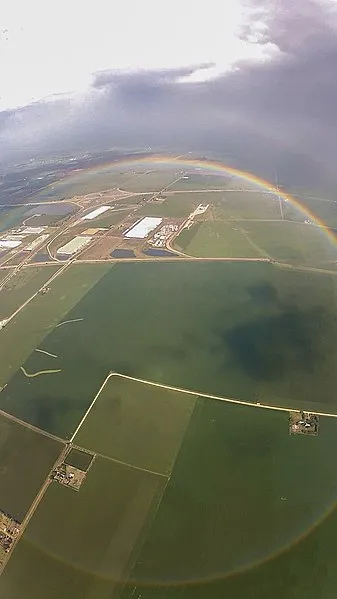Spring is taking a break in Greece as rainy weather is what we had yesterday and what comes usually after the rain? A rainbow!
 Image source: commons.wikimedia.org - Creator: Arne-kaiser - License: CC BY-SA 4.0
Image source: commons.wikimedia.org - Creator: Arne-kaiser - License: CC BY-SA 4.0
Now, if you look closer, you'll see something that doesn't match.
Wait, wait! Are there stars in the sky?
Oh yeah! And this, my friends, is not a rainbow but a moonbow (or a lunar rainbow if you prefer)!
A moonbow? But it looks like a rainbow, are you sure?
Of course I am. Well, technically it is a rainbow, only it is caused by the moon. First, let's see how a rainbow is formed and then we'll explain the differences.
A rainbow is a meteorological phenomenon, an optical illusion from the combination of dispersion, refraction and reflection of light. In order to see it you need:
- Water in the air: we need water droplets in the air, from rain or mist, at a direction opposite the sun, that's the reason you can see it to the west in the morning time and to the east in the evening.
- The sun at the right place: to see a rainbow the sun must be low in the sky. You will spot it if you look at an angle of about 40° from the ground.
How is it done?
 Kes47 through: commons.wikimedia.org - license: CC BY-SA 3.0
Kes47 through: commons.wikimedia.org - license: CC BY-SA 3.0Each water droplet acts like a single prism, when they all combine the final result is a colorful circular band across the sky (with a pot of gold on its end and a leprechaun guarding it). Sunlight enters the suspending water droplets, the rays are refracted (bended due to the change in the medium), internally reflected (bounce back) on the walls of the droplet and then refracted again as they exit the water medium and return to the air; but the incoming ray won't be the same coming out, as some of it will be reflected once more at the time of the second refraction and will exit the droplet from the opposite side or keep reflectng inside the droplet. The double refraction can occur in various angles, with the red light frequencies refracted at about 42° and therefore visible at the top of the arc; whereas the blue light is refracted at 40° and is visible at the inner part of it, but the whole visible light (ROYGBIV) spectrum is refracted in every single droplet.
I got it, now how can you do that with moonlight?
This is really rare and difficult to happen, but not impossible. For a moon bow the same requirements must be met:
- water droplets in the air,
- bright moonlight (full moon or near-full-moon phases) opposite the droplets,
- the moon must be low in the sky (not higher than 42° from the ground), and
- there must be darkness, as light might hide it.
Note that, a moonbow's colors are not as bright as a rainbow's. This means it might look white to your eyes, but you can "trick" them using long exposure photography to capture the variety of colors in it.
I really, really want to see it! How can I find one?
Although moonbows are a rarity, there are certain places where you actually have higher chances of witnessing one. That is near waterfalls that create mist layers of splashing water droplets. They are called spray moonbows for this reason. Places like Waimea (Hawaii), Cumberland Falls State Resort Park (Kentucky), Yosemite National Park (California), Plitvice Lakes (Croatia) and Victoria Falls between Zambia and Zimbabwe (Africa) are ideal if you want to experience this miracle first hand.
If you want to, you can always have a look at this gallery from nightskyhunter.com.
Did you know?
 Steve Kaufman through: commons.wikimedia.org - license: CC BY-SA 3.0
Steve Kaufman through: commons.wikimedia.org - license: CC BY-SA 3.0Rainbows do not have a specific location, they are not stationary and they are certainly not tangible. Two different people will see two different rainbows depending on their place and angle of viewing relatively to the light source. Pretty cool, huh? There are as many rainbows in the sky as the possible viewing angles but we can only see one every time!
We can see rainbows as colorful arcs in the sky, but they are actually full circles. On the ground we miss the lower half of the circle because there are no water droplets for the light to refract, disperse and reflect through. But if you can make it higher, on a tall building or, even better, a plane, you might get lucky to view the whole of it!
(You miss so much when your feet stay pinned on the ground, flying changes so much of your perspective... in many ways)
References
wikipedia.org_1
wikipedia.org_2
discoverykids.com
physicsclassroom.com
wonderopolis.org
timeanddate.com

Thank you so much for your time!
Until my next post,
Steem on and keep smiling, people!

